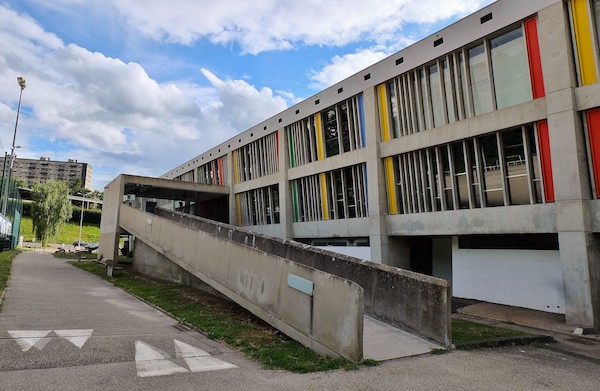
JHK in The American Conservative: How a Massive Societal Shift Could Undo a Century of Ugly Building
James Howard Kunstler is the New Urbanism Fellow at The American Conservative.
His monthly TAC columns appear in the New Urbs section.
To support The American Conservative, click to read JHK’s essay there.
How a Massive Societal Shift Could Undo a Century of Ugly Building
The new disposition of things will demand a revival of the architectural wisdom of the ages.
July 29, 2020

Firminy, Maison de la culture, designed by Le Corbusier. Thierry Llansades/Flickr
Anyone who has traveled outside the USA to towns and cities in civilized foreign lands, and who then comes home to the punishing wilderness of American suburbia must, at least, suspect that something crucial in our culture has been out of order for a long time. It’s taken decades to build out the San Fernando Valley, and the countless other grotesque environments for daily life like it from sea to shining sea. What’s painfully absent is the quality I will call charm, and that is no small thing.
The conditions in a place like the commercial highway strip—of which there are tens of thousands—cast a spell of deep existential horror upon our everyday lives. You get not just the totalizing renunciation of conscious artistry in the design and assembly of our surroundings, but also the ferociously aggressive and immersive ugliness we’ve managed to substitute for it. This immersive ugliness of the highway strip is actually entropy-made-visible, and entropy is the force in nature that you really don’t want to mess with, since it is the bringer of stasis and death. Naturally, we’re repelled by it. And yet, we’ve foolishly managed to surround ourselves by it.
The quality of charm in man-made places is quite the opposite of what entropy represents. It attracts us. It invites us into the adventure of living within nature and within our own humanity. It alerts us that we have a reason to live. It’s the quality that unifies the things of this world and produces in humans a bond of gratitude for being here. You don’t have to work harder to achieve a charming place than you do to design, finance, permit, and construct an arterial highway of muffler shops, fast food shacks, big-box stores, and acres of free parking. But you have to know that the difference matters.
Two books might give our ailing culture a clue. The first is the revised edition of Cognitive Architecture (forthcoming this October) by architect and neuroscientist Ann Sussman, with Justin Hollander, an urban design professor at Tufts University. The concise and breezy book introduces a set of straightforward neuro-cognitive discoveries about how the brain interacts with our surroundings that offer an enhanced understanding of the mysteries of charm.
For instance, the visual sector of our brain has evolved to devote more than half its capacity to recognizing faces. Our brain wants to apply that faculty to buildings. Our eyes seek out patterns in them that denote we’re in the presence of humanity. When buildings are detailed correctly, we can read their “faces,” inviting us to understand what we’re looking at. That’s a big reason that traditional buildings come in types, each with its characteristic demeanor. They inform us that we’re seeing a house, a church, a city hall, or a power plant. Sometimes, those buildings even wear hats (they have interesting roofs).
World War I changed all that, Sussman and Hollander say. The slaughter of the trenches so shattered a generation of young men that their post-traumatic stress transformed culture dramatically. Modernist architects such as Walter Gropius and Ludwig Mies van der Rohe were so emotionally damaged by their war trauma that instead of visually processing human faces in their buildings, they neurotically reenacted the horror by designing buildings that looked like bunkers and fortifications. The blank façade ruled. Ornament was deep-sixed. Windows became mere holes in the wall. Building typologies were done away with so that one might mistake an art museum for an insecticide factory. World War II only reinforced the PTSD of the earlier war, and Modernism has ruled ever since, despite the discomfort and revulsion it provokes for many ordinary people.
Mathematician Nikos Salingaros’s straightforward new book, A Theory of Architecture, does a masterful job of revealing the hidden mathematical coding that connects human cognition with architecture that is comprehensible and meaningful to us. Salingaros is a long-time colleague and collaborator with Christopher Alexander, whose groundbreaking 1977 book A Pattern Language unlocked the lost secrets of creating successful human environments—places in which people actually liked being. Salingaros takes it deeper into the science. Buildings express themselves in nested hierarchies of form that must be mathematically consistent with each other at each scale, from the smallest detail to the thing as a whole. “The suppression of ornament…” he says, “results in alien forms that generate physiological and psychological distress.” He has a great deal more to say about the connections between human emotional needs, physics, and the interplay between them, and it goes a long way towards explaining the catastrophe of the built environment in our time.
The odd part of all this is that it’s now necessary to get the backing of science to validate what used to come naturally: the ability to build pleasing places. Architects from Vitruvius through Brunelleschi, Bullfinch, Richard Morris Hunt, and thousands of others were eager to execute building designs that complied with the laws of the universe and the operations of the human brain. They all received some sort of training, of course. That knowledge and skill was transmitted by a long succession of their predecessors back to the most distant antiquity. A few traditionalist hold-outs survived the Modernist decades, disdained and pitied by the mandarins of academia and the celebrity starchitects.
Now, the coronavirus, the plague of our time, has accelerated another turning of history. Western civ and the economic horse it rode in on are suddenly in a lot of trouble. The familiar certainties of modernity itself are collapsing, along with manufacturing supply lines, capital flows, and energy supplies. The result of all that is liable to be a society far less intoxicated with technological triumph and grad school mystification. A lot of the fabricated, modular building materials of the past hundred-odd years that made Modernist architecture possible will no longer be so easily available—concrete, plate glass, titanium claddings, steel beams, aluminum trusses, and much more.
This new disposition of things, which we are quite unprepared for, will demand a revival of the building wisdom of the ages. It will be a vast improvement over the anxious, neurotic exercises that can now be plainly described as yesterday’s tomorrow. The necessary return to traditional modes and materials will yield a revived architecture of grace notes, humility, and decorum. Wait for it!
James Howard Kunstler is The American Conservative’s New Urbanism Fellow. He is the author of numerous books on urban geography and economics, including his recent work, Living in the Long Emergency: Global Crisis, the Failure of the Futurists, and the Early Adapters Who Are Showing Us the Way Forward.










